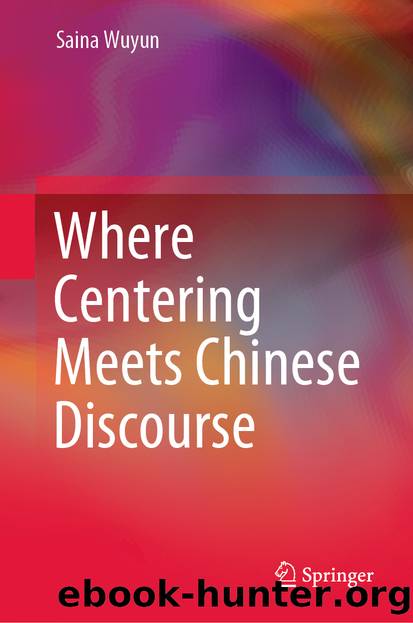Where Centering Meets Chinese Discourse by Saina Wuyun

Author:Saina Wuyun
Language: eng
Format: epub
ISBN: 9789811586668
Publisher: Springer Singapore
In this structure, âbei1â is the passive marker, which functions basically in the same way as the English âBEâ+â_en,â and âbei2â is the preposition, which introduces the agent theta role. âbei1âand âbei2â are combined via a âhaplologyâ procedure and present as one âbeiâ in a passive sentence.
3.4 Centering Theory Revisited
One of the main tasks of this chapter is to utilize the theoretical framework of Centering Theory refined in Chap. 2 to study the discourse function of Chinese bei utterance. Hitherto this task has been fulfilled smoothly: I have revealed the Cb transition state patterns of discourse segments with bei utterance, and also discovered the division of labor between bei utterance and bei object in discourse. Comparisons between long and short passives are rendered with quite exciting results. Now, it is essential that we pay Centering Theory a revisit, with the aim of verifying the improved definitions that were left open in Chap. 2.
Chapter 2 redefined two essential definitions in Centering Theory, i.e., center and utterance, as listed below.
DEFINITION of center: Center is a semantic entity that has its syntactic realization in an overt form or as a pro, but not necessarily as a full NP constituent.
Download
This site does not store any files on its server. We only index and link to content provided by other sites. Please contact the content providers to delete copyright contents if any and email us, we'll remove relevant links or contents immediately.
Cecilia; Or, Memoirs of an Heiress — Volume 1 by Fanny Burney(32434)
Cecilia; Or, Memoirs of an Heiress — Volume 2 by Fanny Burney(31871)
Cecilia; Or, Memoirs of an Heiress — Volume 3 by Fanny Burney(31854)
The Lost Art of Listening by Michael P. Nichols(7406)
Asking the Right Questions: A Guide to Critical Thinking by M. Neil Browne & Stuart M. Keeley(5635)
We Need to Talk by Celeste Headlee(5542)
On Writing A Memoir of the Craft by Stephen King(4863)
Dialogue by Robert McKee(4321)
Pre-Suasion: A Revolutionary Way to Influence and Persuade by Robert Cialdini(4150)
I Have Something to Say: Mastering the Art of Public Speaking in an Age of Disconnection by John Bowe(3840)
Elements of Style 2017 by Richard De A'Morelli(3307)
The Book of Human Emotions by Tiffany Watt Smith(3238)
Fluent Forever: How to Learn Any Language Fast and Never Forget It by Gabriel Wyner(3028)
Name Book, The: Over 10,000 Names--Their Meanings, Origins, and Spiritual Significance by Astoria Dorothy(2939)
Good Humor, Bad Taste: A Sociology of the Joke by Kuipers Giselinde(2903)
Why I Write by George Orwell(2874)
The Art Of Deception by Kevin Mitnick(2736)
The Grammaring Guide to English Grammar with Exercises by Péter Simon(2710)
Ancient Worlds by Michael Scott(2625)
